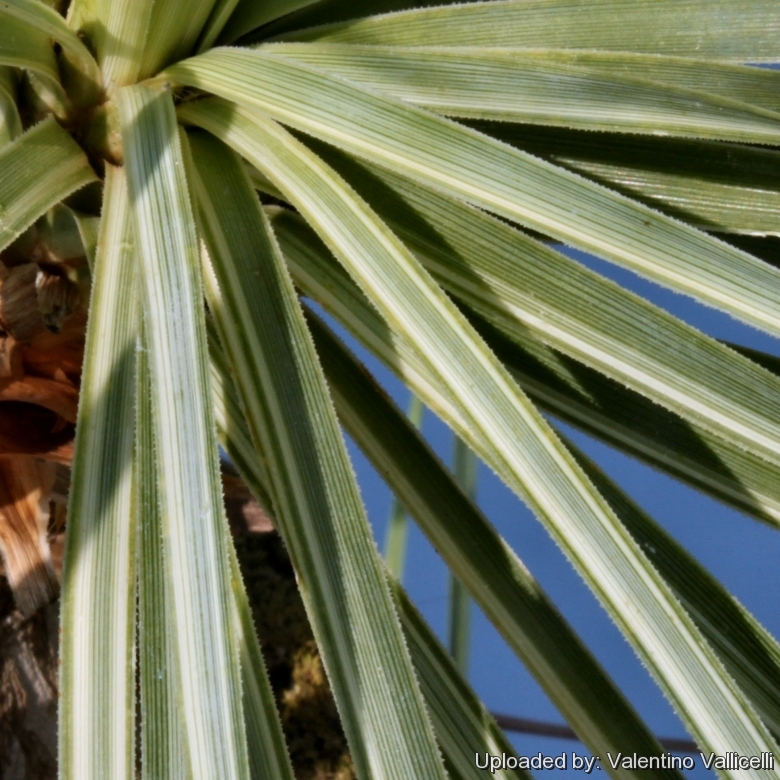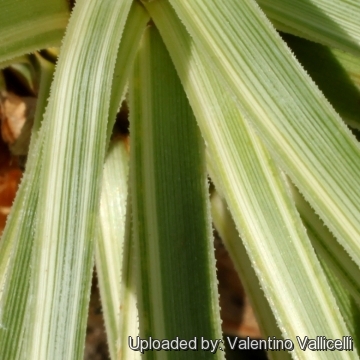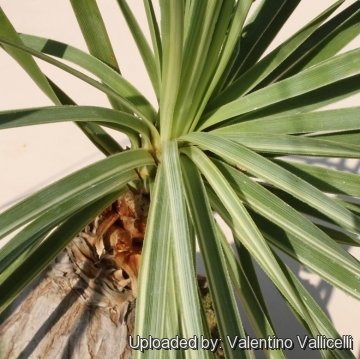
Beaucarnea gracilis f. variegata Photo by: Valentino Vallicelli
This very showy and delightfully colorful plant brighten a Beaucarnea (Nolina) collection by contrasting its highly variegated foliage with that of the green types.
Origin and Habitat: Garden origin.
Synonyms:
See all synonyms of Beaucarnea gracilis
Common Names include:
ENGLISH: Variegated Ponytail Palm, Variegated Nolina, Variegated Elephant-Foot Tree, Variegated Bottle Palm
Description: It is a small tree or large shrublike succulent species with many slender, curving vertical stems, that emerge from a large beautiful globose woody base, it is related to the well-known ponytail plant (Nolina recurvataSN|20519]]SN|20519]]), it has bark that would look at home on a pine tree. It is closely related to the Tree Yuccas and branched like them at the top. It can grow up to 3-5 m in height in the ground( but sometime i can reach imposing dimension up to 12 m overall)
Stem (succulent caudex): The caudex (comprising the bulbous basal part of the trunk and the upper part of the rootstock) is enormously swollen, a large part of which is visible above ground. It is more or less circular in cross-section, with variously shaped and irregularly contorted vertical stems. The trunk is covered with thick grey to brown bark that ages into polygonal or rectangular plates.
Leaves: Very narrow, grassy, stiff, with smooth grooves and nearly smooth margins, nearly flat, green to bluish-green, leaves grow from the top like a ponytail (hence the popular common name)
Flowers: The species is dioecious (there are male and female plants) , flowers every year.
Fruit: Long-pedicellate.
Variegated form The variegated form is a very desirable plant but still rare. It is similar to the common Pony-tail Plant except that it has leaves striped with various colours of white, cream, and several shades of yellow and green. It retains its foliage year round and is thus a valuable and decorative houseplant.
Subspecies, varieties, forms and cultivars of plants belonging to the Beaucarnea gracilis group
 Beaucarnea gracilis Lem.: It is a small tree or large shrublike succulent species with many slender, curving vertical stems, that emerge from a large beautiful globose woody base.
Beaucarnea gracilis Lem.: It is a small tree or large shrublike succulent species with many slender, curving vertical stems, that emerge from a large beautiful globose woody base. Beaucarnea gracilis f. variegata hort.: has leaves striped with various colours of white, cream, and several shades of yellow and green.
Beaucarnea gracilis f. variegata hort.: has leaves striped with various colours of white, cream, and several shades of yellow and green.
Bibliography: Major references and further lectures
1) James Cullen, Sabina G. Knees, H. Suzanne Cubey “The European Garden Flora Flowering Plants: A Manual for the Identification of Plants Cultivated in Europe, Both Out-of-Doors and Under Glass” Cambridge University Press, 11/ago/2011
2) Carol C. Baskin, Jerry M. Baskin "Seeds: Ecology, Biogeography, and Evolution of Dormancy and Germination" Elsevier, 2001
3) Cardel,Y, Rico-gray, V, Garcia-Franco, J. & Thien, B.M, "Ecological status of Beaucarnea gracilis, an Endemic species of the Semiarid Tehuacán valley, México" in Conservation Biology, 11(2), pp. 367-374. 1997
4) Paul C. Standley "Trees and shrubs of Mexico" Volume 1 Smithsonian Institution, 1967
5) Evan Hillhouse Methven Cox “New Flora and Silva” Volume 11 Dulau & Company, limited, 1938
6) “The New Plantsman” Royal Horticultural Society, 1998
 Beaucarnea gracilis f. variegata Photo by: Valentino Vallicelli
Beaucarnea gracilis f. variegata Photo by: Valentino Vallicelli Beaucarnea gracilis f. variegata Photo by: Valentino Vallicelli
Beaucarnea gracilis f. variegata Photo by: Valentino Vallicelli Beaucarnea gracilis f. variegata Photo by: Valentino Vallicelli
Beaucarnea gracilis f. variegata Photo by: Valentino VallicelliSend a photo of this plant.The gallery now contains thousands of pictures, however it is possible to do even more. We are, of course, seeking photos of species not yet shown in the gallery but not only that, we are also looking for better pictures than those already present.
Read More... Cultivation and Propagation: It is a very tolerant plant that can withstand temperatures of -5 Celsius degrees for short periods, but its exact hardiness is unknown. Because of its extreme drought tolerance, it makes a great container plant for light shade to full sun, or is an excellent foliage accent in a dry garden in warm regions. Might look its best in a vase shaped terra cotta pot to allow the leaves to drape downwards. It needs moderate water when actively growing, little water the rest of the time, if established. Outdoor it needs heavy soil with excellent drainage and circulating dry air. It is a tough plant. Having been bred to endure dry air and drought, it will survive for years in less than ideal conditions. It can stay in the same pot for a number of years since it prefers to be a bit rootbound.
Propagation: Seeds; stem cuttings. (it cannot be reproduced by leaves cuttings).













